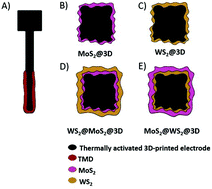Local electrochemical activity of transition metal dichalcogenides and their heterojunctions on 3D-printed nanocarbon surfaces†
Abstract
Transition metal dichalcogenides (TMDs) have shown to be promising catalysts for the electrochemical hydrogen evolution reaction (HER) and 3D-printing enables fast prototyping and manufacturing of water splitting devices. However, the merging of TMDs with complex 3D-printed surfaces and nanostructures as well as their localized characterization remains challenging. In this work, electrodeposition of MoS2 and WS2 and their heterojunctions are used to modify thermally activated 3D-printed nanocarbon structures. Their electrochemical performance for the HER is investigated macroscopically by linear sweep voltammetry and microscopically by scanning electrochemical microscopy. This study demonstrates different local HER active sites of MoS2 and WS2 within the 3D-printed nanocarbon structure that are not solely located at the outer surface, but also in the interior up to ∼150 μm for MoS2 and ∼300 μm for WS2.

- This article is part of the themed collection: Chemistry of 2D materials: graphene and beyond


 Please wait while we load your content...
Please wait while we load your content...